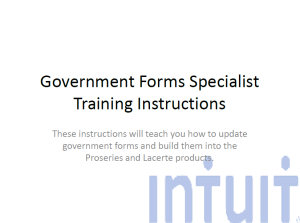Click image above to open PDF of presentation
Technical communications is all about providing easy-to-use information to a target audience. When that target audience is students, technical communications is very similar to teaching. Like teachers, technical writers are often showing people how to do something new. Instructions, process documents, standard operating procedures (SOP’s) are all examples of this. I have been a teacher and a technical communicator so I am in the unique position of having both experiences to compare. I combined these skill sets in a process document for the job I did at Intuit while I was there. I created training instructions in PowerPoint and print document formats.
I recently experienced their existing training firsthand and subsequently performed the duties I learned so I have a fresh viewpoint for how to improve their current training process. The documents I created aren’t meant as standalone documents; rather they are meant to support and enhance the existing training. The biggest value I am adding with these documents is reducing the mentor to trainee time commitment after the initial training period is over.
After the 1 week training class, a new hire should be able to access my documents and use them to successfully complete their job without needing to ask for help from their mentor as often. The goal here is to free up the mentor’s time, so they are more productive during the beginning stages of a new hire’s employment period. These documents will also help improve the quality of a new employee’s work.
I put the content into a power point slide, but the ideal interface would be a computer-based app that would run constantly in the background prompting the user throughout the process. This is especially useful since all of the tools needed to complete the process are computer-based. Also this format would allow for relevant pop-up reminders, helpful hints, and cautions as the user progresses through the system. As the user’s competence increases, they could turn off the reminders that they no longer need.
The powerpoint format will at least show the graphic design and layout I have chosen. I have included underlined text that would indicate links to more information if it were an actual computer-based app. The print document is provided to go along with the slides since some people prefer to have a tactile interaction with information.


